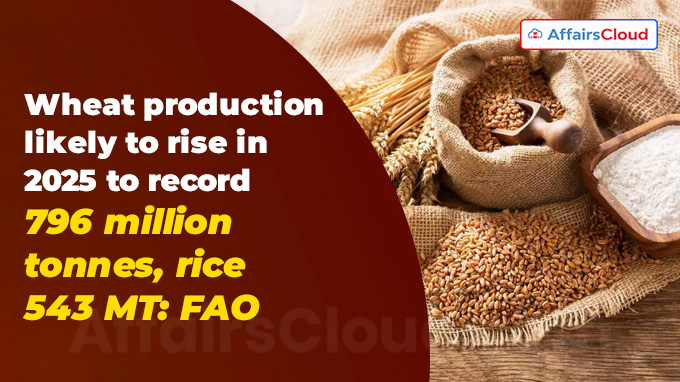 In March 2025, the United Nations (UN) Food and Agriculture Organization (FAO) released two key reports: the ‘Cereal Supply and Demand Brief’ and the ‘Crop Prospects and Food Situation Report’.
In March 2025, the United Nations (UN) Food and Agriculture Organization (FAO) released two key reports: the ‘Cereal Supply and Demand Brief’ and the ‘Crop Prospects and Food Situation Report’.
- The report on global grain production predicts that wheat production may reach 796 million tonnes (Mt) in 2025, marking a 1% increase from the previous year. This growth is driven by expanded wheat planting in the European Union, particularly France and Germany.
- The report on crop prospects provides insights into how different regions are affected by weather patterns and other agricultural challenges.
Key Highlights of the Global Grain Production Report:
i.FAO expects world grain reserves to shrink by 1.9%, bringing the total to 869.3 Mt in 2025. While Russia and Ukraine may see an increase in stocks, other regions might experience a decline.
ii.FAO has revised its forecast for global grain production in 2024 to 2,842 Mt, slightly higher than in 2023.
iii.The total consumption of cereals is also expected to increase, reaching 2,867 Mt in 2024/25, mainly due to record rice consumption. However, wheat consumption is expected to remain stable,
iv.Rice production globally is expected to set a new record of 543 Mt in 2024/25, driven by positive crop prospects in India and favourable growing conditions in Cambodia and Myanmar.
v.The stock-to-use ratio, which measures how much grain is available compared to consumption, is forecasted to drop to 29.9%. Despite this reduction, FAO considers it a stable level.
vi.At the same time, global grain trade is expected to slow down, with FAO revising its trade estimate to 484.2 Mt, marking a 5.6% decline from the previous year.
Key Highlights of the Crop Prospects and Food Situation Report:
This report is published three times a year (four times before 2023) and provides a forward-looking analysis of the food situation by geographic region, focusing on the cereal production outlook, market situation and food security conditions, with a particular attention on Low-Income Food-Deficit Countries (LIFDCs).
i.FAO reported that 45 countries need food assistance, including 33 in Africa, 9 in Asia, 2 in South America and the Caribbean, and 1 in Europe.
- Conflict and instability remain major factors behind food shortages, with Gaza (Palestine) and Sudan facing the worst food crisis.
ii.The report notes lower grain output in North Africa due to poor rainfall, while southern Africa may recover with better weather. Far East Asia’s wheat production may rise, but the Near East could see declines.
iii.Argentina’s maize faces stent disease, though Brazil’s yields may stabilize output. Mexico’s dry conditions affect seedlings, but better weather in Central America and the Caribbean may boost harvests.
About Food and Agriculture Organization (FAO):
Director General (DG)– Qu Dongyu
Headquarters– Rome, Italy
Established– 1945




